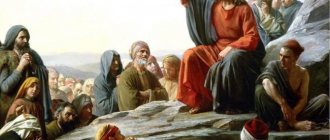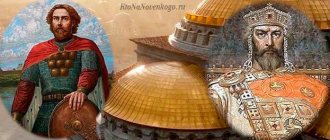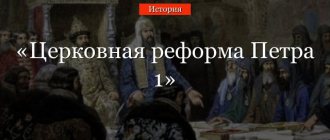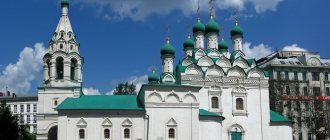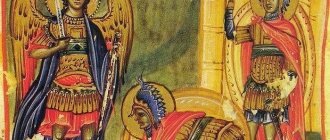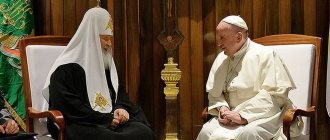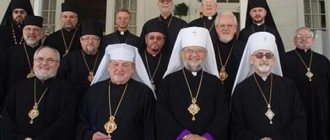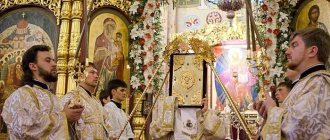CHRISTIANITY (Greek Χριστιανισμός, Latin Christianismus), the largest world religion, founded in the 1st century. Jesus Christ. It is represented by numerous (more than 20 thousand) denominations and sects, each of which claims to be the status of a true Church. The largest of them (2015): Catholicism (approx. 1.2 billion believers), various. denominations of Protestantism (approx. 800 million), Orthodoxy (approx. 280 million), ancient Eastern churches (anti-Chalcedonites; see art. Chalcedonites) and the Assyrian Church of the East (70–80 million believers).
Story. The Beginning of Christianity
"The Descent of the Holy Spirit on the Apostles." Mosaic fragment. Beginning of the 11th century Monastery of Osias Loukas (Greece).
(1st century) occurred in line with the prophecies of the Bible about the coming of the Messiah. Initially, the preaching of Christ and the apostles was carried out in Judea and neighboring regions and was addressed to the Jews, but later it turned to all nations. After the Resurrection of Christ (c. 33), a single community of believers arose - the Church (see Art. Pentecost). Paul and other apostles preached the Gospel among the Greco-Roman population of Syria (in the capital of which, Antioch, the term “Christian” arose), Asia Minor, Greece and Rome. The Council of Jerusalem (c. 50) freed non-Jewish Christians from observing the norms of Judaism. Closely connected with the Jewish diaspora, early Christianity subsequently, especially after the destruction of the Second Temple of Jerusalem (70), became isolated from Judaism; at the same time, the Old Testament remained part of the Holy Scriptures.
Spread of Christianity
(1st – early 4th centuries) to Rome. empire took place under legislative conditions. ban imposed on followers of the doctrine no later than the end. 1st century For refusal to participate in the official religious in cults, Christians were accused of “atheism” and insulting the state; the secrecy of their meetings gave rise to rumors about the extreme immorality of the teaching. During this period there were persecutions of Christians, the largest during the reigns of the emperors Valerian (253–260), Diocletian and Galerius (293–311). But mass executions for beliefs aroused sympathy, and the courageous behavior of the martyrs aroused respect for X. Days of remembrance for victims of persecution gave rise to the tradition of venerating saints (see Art. Canonization). At this time, the formation of Christian worship took place, the formation of 3 degrees of priesthood (deacon, presbyter, bishop) and local church organization (see Diocese, Church Councils). Christian literature emerges: early Christian apologists refute the accusations against X., and dogmatics develops in polemics against Gnosticism and other heresies. X. spread throughout Rome. empire, as well as in the buffer states of the Roman-Iranian borderland, in one of which (Osroene) it even received official status. religion (202). 301 traditionally refers to the adoption of X. in Armenia.
Prerequisites for the occurrence
In the 1st century BC e. the political position of almost any pro-state formations was extremely unstable: some, conquering others, took a dominant position, and then, pushed aside by others, quickly fell into decline.
The most popular theory today about the origins of Christianity states that this religion originated in ancient Palestine. Palestine was under the yoke of foreigners for a long time, then it managed to free itself and briefly become independent, but in 663 BC. e. everything changed again: Gnaeus Polteus (Roman military leader) captured her regions, and Palestine lost its freedom. From now on, it was officially part of the ever-expanding Roman Empire.
The loss of independence gave rise to discontent among all segments of the population, but it was especially hard for the most disadvantaged. The feeling of injustice of what was happening grew, the local population dreamed of a return to the previous order.
Thus the ground was prepared for the emergence of a new creed, which promised to reward everyone according to his deserts. Christianity did not arise on its own: it matured “in the womb” of Judaism. People's minds were already prepared for the idea of fair retribution that awaits anyone living on Earth after death. The Old Testament tradition already existed.
An additional role in the emergence of a new doctrine was played by the works of ancient Greek philosophers, especially Seneca. In them, an important place was occupied by thoughts about repentance, about the original sinfulness of all people, about the need to submit to fate.
The era of the Ecumenical Councils
(4th–9th centuries, see Ecumenical Councils) originates from the appeal of the emperor. Constantine the Great (312) and the publication of the Edict of Milan (313), which removed all restrictions from X. In legal terms freedom and patronage from the emperors of X. became the main thing, and from the end. 4th century and the only official religion Rome. empires. The construction of temples is underway, pilgrimage and veneration of relics and relics are developing. The underlying distinction between the worldly and spiritual principles led to the formation of the so-called system. symphonies of authorities: the state and the Church act as independent institutions established by God, ensuring the material and spiritual well-being of society. Church-wide norms, both doctrinal (dogmas) and disciplinary (canons), are established at councils of bishops. But their maintenance is entrusted to the imp. power, which in special cases initiates imperial-wide Ecumenical Councils, the first of which took place in 325, and the last, 7th, in 787 (finally approved in 843). During discussions on issues of triadology (the doctrine of the Holy Trinity) and Christology, a galaxy of authoritative writers (holy fathers) emerged, whose opinions determined the direction of theological thought. Teachings rejected by church tradition are condemned as heretical, their leaders and adherents are subject to anathema and exile. The establishment of a clear distinction between orthodoxy (correct opinion) and heresy often took painful forms and caused opposition movements to fall away from the official (“Catholic”, “Orthodox”) religion. Arianism in the 4th–7th centuries. spread among the Germans. peoples (Goths, Vandals, Lombards); Nestorianism in the 5th–7th centuries. gradually took root in the Syriac-speaking Church of the East in Iran; Monophysitism in the 5th–6th centuries. became popular among Westerners. Syrians, Copts, Armenians and Ethiopians. During the conciliar, or patristic, period, monasticism arose and rapidly developed. The church administration was formed. structure and system of 5 patriarchates. Missionary work continues. X. spread among the “barbarian” peoples of the West. Europe (Ireland, England, Germany), took root in Aksum (4th century), Nubia (6th century), Georgia and Caucasus. Albania (4th century), reached India and China. To the beginning 7th century X., despite the internal division, dominates among world religions. But the situation changes dramatically with the advent of Islam.
Emperor's welcome speech
For the first time, the hierarchs of the Christian church gathered for a congress not just openly, but with government support. In total, more than 300 bishops gathered in Nicaea. Among them were those who just recently languished in prisons, suffered in hard labor, and endured torture for their faith.
Article on the topic
Jesus Party. Can science interpret the Gospel?
Among the participants in the council were bishops not only from within the Roman Empire. Delegates arrived from Armenia, Persia, Pitiunt in the Caucasus, and Scythia. Of the major representatives of Christianity of that era, only Bishop Sylvester of Rome was absent, who sent two presbyters in his place.
After the grand opening, which took place on a grand scale and pomp, the meetings of the cathedral began, which were personally chaired by Emperor Constantine.
In his opening speech, Constantine said: “Do not delay, O friends, servants of God and servants of our common Lord the Savior! Do not hesitate to consider the reasons for your differences at the very beginning and resolve all controversial issues through peaceful resolutions. Through this you will accomplish what is pleasing to God and bring the greatest joy to me, your fellow servant.”
Despite this, it was not possible to achieve mutual understanding. Arius and like-minded people stubbornly stood their ground; his opponents accused him of schismatics and apostasy. The meetings of the council turned into an endless squabble, sometimes teetering on the brink of assault.
Fresco depicting the First Council of Nicaea. Photo: Commons.wikimedia.org
Medieval period
(9th–15th centuries) is characterized by unrelenting pressure from the Muslims. peace and growing alienation between Christians in Western and Eastern Europe. Arab conquests 7th–8th centuries led to a decrease in the territory of the East. Roman Empire (Byzantium), Middle East, North. Africa and Spain fell under the rule of the Caliphate. Sharia law defines Islam as a revealed religion, “corrupted” by Christians, who are obliged to submit to Muslims, receiving protection under certain conditions (see Art. Zimmiah). In the West Europe against the backdrop of political degradation. institutions, the role of the papacy increased (see Pope), which began to lay claim to political power. power. Against this background, there was an ecclesiastical break between Rome and Constantinople (1054), aggravated by conflicts between Byzantium and participants in the Crusades, the fourth of which ended with the sack of Constantinople (1204). Attempts to conclude a church union (Lyon, 1274; Florence, 1439) did not lead to the resolution of dogmatic, ritual and other contradictions (for example, about the Filioque, celibacy, purgatory). European Christianity was divided into Latin (Catholic) and Greek (Orthodox), the latter's sphere included the countries of the East. Europe (except Poland, Czech Republic, Hungary and Croatia) and Rus' (see Baptism of Rus'). By the 15th century Most Orthodox states, including Byzantium (1453), came under the rule of the Ottoman Empire, and the role of leader of the Orthodox world passed to the Russian state. The doctrine “Moscow is the third Rome” arose. During the Renaissance, ideas of humanism, dating back to the language, spread in Europe. antiquity and in many respects alien to Christianity.
New time
(16th–19th centuries) was marked by a deep crisis in Western Christianity. Non-church religions. movements that had previously been suppressed through the Inquisition spun out of control and received national support. elite As a result, during the Reformation, the so-called. Protestants diff. interpretations (see Lutheranism, Calvinism, Anglican Church, Anabaptists). After the Counter-Reformation and religions. wars, Europe was split into Catholic and Protestant regions. This division was carried over to the colonial countries, primarily to the South. and Sev. America, where X. became the dominant religion. Secularization and the ideas of the Enlightenment contributed to the further weakening of traditions. religious institutions. Ideological movements appeared that openly broke with Christianity. De-Christianization in France (1790s) led to reprisals against clergy and destruction of religious buildings.
Notes
- ↑
BBC,
BBC—Religion & Ethics—566, Christianity - ↑
Briggs, Charles A.
The fundamental Christian faith: the origin, history and interpretation of the Apostles' and Nicene creeds.
C. Scribner's sons, 1913. Online: https://books.google.com/books?id=VKMPAAAAIAAJ - ↑ 12
Major Religions of the World Ranked by Number of Adherents - ↑ Christianity
- article from the Great Soviet Encyclopedia (3rd edition) - ↑
Binns, John.
An Introduction to the Christian Orthodox Churches
. Cambridge: Cambridge University Press, 2002, p. 30. ISBN 0-521-66738-0. - ↑
TSB – Article: Armenian Apostolic Church - ↑
CIA – The World Factbook: Armenia - ↑
Max Diamont. Jews, God and History - ↑
Adherents.com: By Location - ↑
Adherents.com - Religion by Location - ↑
Largest Religious Groups in the USA - ↑
Adherents.com: By Location - ↑
Adherents.com: By Location - ↑
Adherents.com: By Location - ↑
Adherents.com: By Location - ↑
Catholic News | Vatican: Priest numbers show steady, moderate increase | American Catholic - ↑
Annuario Pontificio - ↑ 12
Status of Global Mission 2011 - ↑
Statistical report. Annual council of the General Conference Committee, October 9-14, 2009 - ↑
Eastern Orthodox Church — Information on the Eastern Orthodox Church Denomination - ↑
The Armenian Church Today (inaccessible link) - ↑
The Armenian Church and Chalcedon (inaccessible link) - ↑
Encyclopedia Coptica - ↑
World Council of Churches - ↑
National Geographic - ↑
Schematic history of Christianity - ↑
World Council of Churches - ↑
Georgian Orthodox Church - website of the Moscow Patriarchate - ↑
GEORGIAN ORTHODOX CHURCH (inaccessible link) - ↑
Ronald Robertson. Eastern Christian Churches: Church Historical Directory - ↑
Brief history of the Georgian Orthodox Church - ↑
Official website of the Georgian Orthodox Church - ↑
Georgian Orthodox Church, Encyclopedic Dictionary - ↑
TSB - ↑
Orthodoxy in our days, MN Bessonov, Publisher-Politizdat, 1990. P. 80
Recent period
(20–21 centuries) is characterized by progressive de-Christianization. In Russia, since 1917, the process of de-Christianization took on a radical character and was accompanied by mass persecution (see New Martyrs) and active propaganda of atheism. However, it is in Russia that at the end. 20th century There has been a growth in H.'s influence in social and cultural life. Attempts to systematically respond to new challenges and overcome the disunity of Christians were ecumenism and the creation of the World Council of Churches (1961), the reform movement in Catholicism, the idea of a Pan-Orthodox Council in Orthodoxy and interfaith dialogues.

